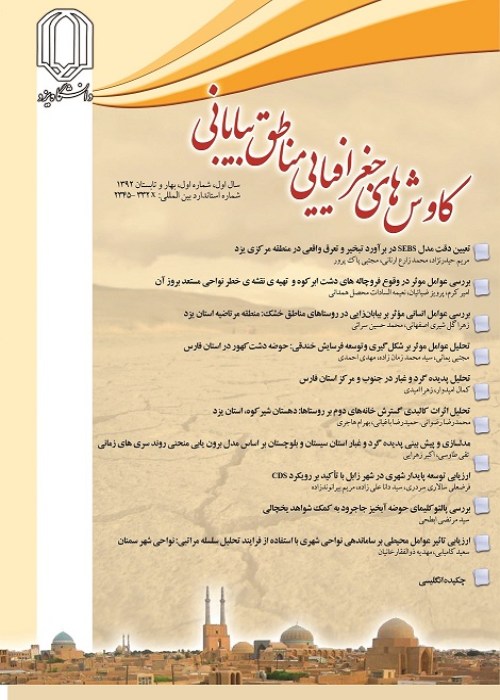Detection of Spatio-temporal variations of precipitations trend in southeast of Iran
Precipitation as the most important climatic element is always studied from two perspectives of time and place. Emphasis on the time perspective determines temporal changes and emphasis on the location perspective determines the spatial variation of precipitation. Since Iran is located in an arid and semi-arid region, it lacks large internal and adjacent water resources to supply moisture to its precipitation, and as a result, most of its precipitation moisture sources must be supplied from the surrounding water levels. One of the methods that can be used to study the course of rainfall in the past and present is to analyze the trend of time series at different scales. So far, statistical methods have been presented for the analysis of time series routines, which can be divided into two general categories: parametric and non-parametric methods. Southeastern Iran, which includes Sistan-Baluchestan province, Kerman, southern Khorasan and the eastern parts of Hormozgan province, They are one of the arid regions of Iran. Restriction on water resources and annual precipitation in this part of the country have severely limited agricultural and industrial activities. The lives and deaths of the majority of people are also related to the low precipitation that falls throughout the year. Therefore, considering that a comprehensive study on precipitation trends in the region has not been done, the purpose of this study is to investigate the annual and seasonal precipitation trends by stations in southeastern Iran. The results of this study can play an important role in understanding the precipitation trend in the southeast region for planning related to water resources management, management of unexpected events such as floods and also the optimal utilization of those precipitations.
In order to conduct this study, in order to recruit rainy periods, daily precipitation data were obtained from synoptic stations in the southeast of the country, including selected stations in the three provinces of Hormozgan, Sistan and Baluchestan and Kerman during a 30-year period (1987-2016). Two Mann-Kendall tests and the Sen’s Slope Estimate are among the most common non-parametric methods of trend analysis when considering hydrometeorology. Various studies conducted using these two methods indicate the importance of their widespread use in the rapid evolution of time. Identify the data change using the Man-Kendall method, specify its type and time. The non-parametric Kendall test was proposed by Mann and then developed by Kendall (1975) based on ranking data in a time series. This method is widely and widely used in the analysis of the process of hydrological and meteorological series.
The trend of average annual, seasonal precipitation and maximum 24-hour precipitation in southeastern Iran Considering that in the annual, seasonal and maximum 24-hour precipitation trend diagrams, the intersection of the U and U' sequences above and below the significant lines did not occur, which means that acceptance is random (acceptance of H0 hypothesis) and there is no significant trend (H1) variable. Precipitation is in the southeast of Iran and in fact the condition is -1.96 (ti)< U or 1.96 (ti) >U and has a static series.In the Sen's Slope Estimate test, the total reduction of winter precipitation slope was equal to -0.350 mm, which in the case of 95% confidence of the upper and lower slopes of this slope is equal to -0.123 and -0.835, respectively, and in the case of 99% of the slopes. High and low are 1.604 and -2.318, respectively, per year. The Sen’s Slope Estimate test for annual rainfall, summer, autumn, winter and maximum 24-hour precipitation has estimated the negative precipitation slope. Mann Kendall test estimate shows a decrease in precipitation in winter of -1.71 per year.Annual, seasonal and maximum 24-hour precipitation trend by stations in southeastern IranIn the study of changes in annual precipitation using Mann-Kendall test, it is observed that the annual precipitation trend in most stations in the southeast (except Bam and Chabahar) has a decreasing trend. The Sen’s Slope Estimate showed is the highest precipitation at any given time at Bandar-Lengeh station at -4.16 mm per year. The time series of Man-Kendall test in the seasons of the year indicates that in spring, summer and autumn, the precipitation trend in most stations is decreasing, but this trend is not significant in any of the stations in southeastern Iran and only in winter precipitation In Bandar-Lengeh, Jask and Kish stations, it has a decreasing trend at 95% significance level. Sen’s Slope Estimate data showed that the amount of precipitation decreases in the mentioned stations.
The results of by using Methods the Mann-Kendall test showed that the mean annual precipitation trend as well as spring, summer and autumn seasons of southeast Iran was not significant and only winter precipitation had a significant and decreasing trend. Estimates of the slope of sen indicate that the slope of precipitation in southeastern Iran in winter is -0.350 mm in year. The annual precipitation trend of BandarAbbas, BandarLengeh, Abumousa and Kish stations at 95% and Jask and Iranshahr stations at 90% were significant. Test statistics showed that the highest annual precipitation reduction was at the Bandar-e-Lange station at -4.16 mm in year. In spring, summer, and fall, precipitation was not significant in any of the stations in the southeast of Iran and winter precipitation in Bandar-e-Lengh, Jask, and Kish stations had a 95% significant decrease. Assessment of 24-hour rainfall variations showed that the above mentioned precipitation had a decreasing trend at 99.9% at BandarAbbas stations and 95% at Bandarlange, Jask, Abumousa and Kish stations. According to the tests and analyzes performed in this study, what is certain is that in all stations in southeastern Iran, a significant positive trend in annual, seasonal and maximum 24-hour rainfall was not observed at the level of 99% and 95%, and most precipitation trends from It is a kind of decrease and has revealed the fact of decrease in rainfall in the southeastern climate of Iran during the years 1987 to 2016, which decrease in annual rainfall is mostly related to the winter of -1.71 per year.
- حق عضویت دریافتی صرف حمایت از نشریات عضو و نگهداری، تکمیل و توسعه مگیران میشود.
- پرداخت حق اشتراک و دانلود مقالات اجازه بازنشر آن در سایر رسانههای چاپی و دیجیتال را به کاربر نمیدهد.




